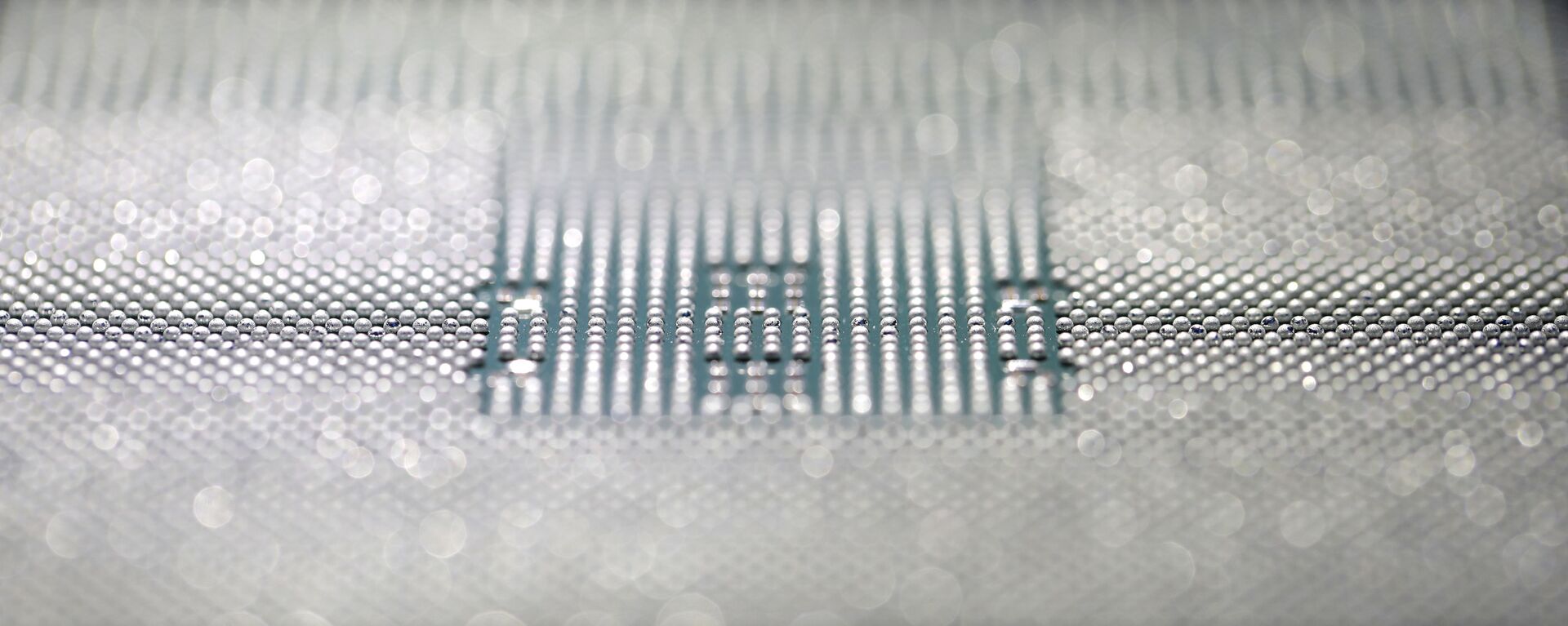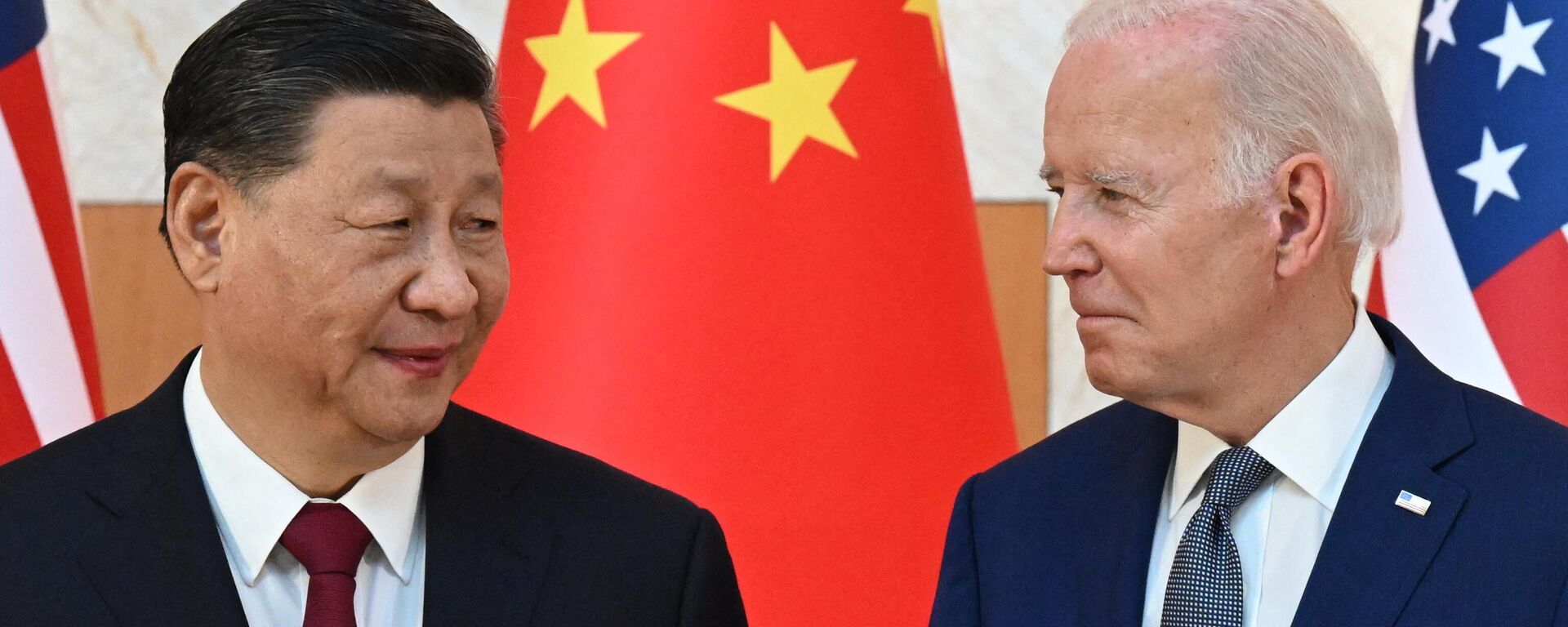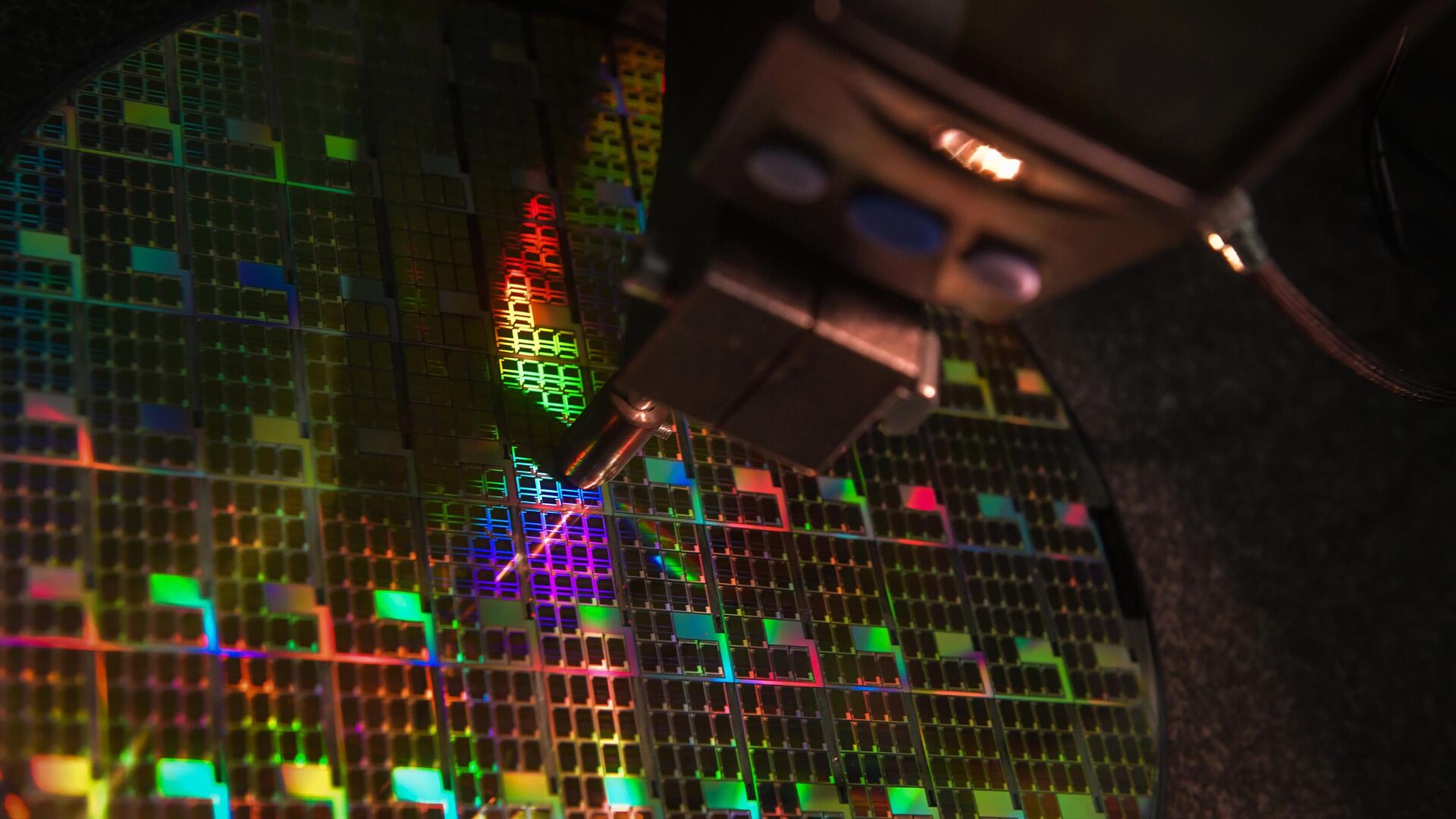https://sputnikglobe.com/20231122/us-china-chip-rivalry-finds-new-flashpoint-1115134803.html
US-China Chip Rivalry Finds New Flashpoint
US-China Chip Rivalry Finds New Flashpoint
Sputnik International
The semiconductor industry is being revolutionized by semiconductor packaging, which involves encasing chips in protective materials, ensuring their safety, and enabling their connection to electronic devices. When comparing this sphere within the semiconductor industry globally, it is evident that the US and China are leading in advancements.
2023-11-22T15:09+0000
2023-11-22T15:09+0000
2023-11-22T15:09+0000
economy
joe biden
china
beijing
jinping
taiwan semiconductor manufacturing company (tsmc)
intel
micron
white house
https://cdn1.img.sputnikglobe.com/img/07e7/07/13/1111991456_0:320:3072:2048_1920x0_80_0_0_3ccbfef9c0d67496bb943c3da0664cc8.jpg
The Biden administration is bent on addressing China's rapid advancements in high-tech sectors, by restricting Beijing's access to advanced semiconductor technology, specifically ultra-modern chips, while they push to ramp up domestic production of these components.An additional and more recent focus of the US strategy targets the semiconductor packaging industry. This sector, essential for enhancing chip performance, has gained prominence in the technological rivalry with China. The evolution of the semiconductor sector has highlighted advanced packaging techniques as a vital area of potential, not just in the US but globally. Despite sanctions, China has been adept at utilizing this sector to expand its influence in the global market, particularly in areas less affected by restrictions on high-end chip fabrication.Until recently, the packaging process in the semiconductor industry, which involves encasing chips in protective materials, was historically underemphasized. This task was predominantly outsourced to Asian countries, notably China, which has become a significant player in this domain. The United States currently contributes a modest portion — about 3 percent — of the global capacity in this area.Jim McGregor, founder of Tirias Research, emphasizes the growing importance of packaging in the semiconductor sector, stating, "Packaging is the new pillar of innovation in the semiconductor industry – it will change the industry drastically." He points out that for China, focusing on advanced packaging provides an alternate route to technological progression, especially in the face of constraints in top-tier chip manufacturing. This focus could help China narrow the technological gap.Responding to these changes, the Biden administration has developed a comprehensive plan. The CHIPS and Science Act is a cornerstone of this strategy, aiming to boost domestic semiconductor production. The Act is also a move to secure the semiconductor supply chain. During recent global chip shortages, the dependence on foreign chip production, including that from China. The US sanctions against China in the semiconductor sector primarily aim to hinder Beijing's ability to develop and manufacture advanced semiconductor chips, which are crucial for a wide range of technologies, from smartphones to military hardware.Additionally, the administration has initiated a National Advanced Packaging Manufacturing Program with a $3 billion budget. This program seeks to establish large-scale packaging facilities in the US, intending to lessen dependence on Asian supply chains and mitigate security risks.According to White House spokeswoman Robyn Patterson, Biden “has made it a priority to ensure America’s leadership in all elements of semiconductor manufacturing, of which advanced packaging is one of the most exciting and critical areas.” The goal is to regain and maintain America's leadership in the semiconductor industry, not just in chip manufacturing, but also in advanced packaging. This dual approach reflects the White House's commitment to enhancing the nation's competitive edge in this critical technological field.A global comparison reveals varied strengths in technology and packaging capabilities in the semiconductor industry. While the US is enhancing its capabilities in advanced packaging, notably through the National Advanced Packaging Manufacturing Program, China, under President Xi Jinping’s Made in China initiative (2015), has already established a considerable presence. Holding approximately 38 percent of the global market share in assembly, testing, and packaging, China, led by companies like JCET Group, challenges the traditional dominance of the US and other technologically advanced nations.The semiconductor sector is experiencing a significant transition, shifting focus from front-end manufacturing to advanced packaging. This shift, driven by the need for greater integration and performance in electronic devices, allows for the combination of various chip types in a single unit, leading to more efficient and economical computing systems. China has particularly capitalized on this technology, partially overcoming its limitations in advanced chip production.The sophistication in packaging technologies is enhancing performance and opening new avenues for market expansion. This trend marks a significant evolution in the semiconductor industry, with advanced packaging emerging as a critical factor in future developments and market dynamics.In the advanced packaging sector of the semiconductor industry, major companies such as Intel, TSMC, and Micron are making significant investments in their own facilities. These investments reflect the growing recognition of the importance of advanced packaging in enhancing the performance of AI chips, a key area of technological advancement. The impact of advanced packaging on AI chip production is substantial, enabling the creation of more efficient and powerful computing systems. Market forecasts and predictions indicate a robust growth trajectory for the advanced packaging sector. This growth is driven by the sector's ability to meet the evolving demands of high-performance computing, including AI applications, signifying a critical shift in the semiconductor industry's focus and investment priorities.Advanced packaging plays a crucial role in overcoming these limitations by enabling the integration of multiple 'chiplets' in a single package, enhancing performance and functionality. The future outlook for the semiconductor industry predicts significant growth and impact of advanced packaging. This technology is expected to drive innovation in chips manufacturing, particularly as demands for high-performance computing and AI capabilities increase, indicating a pivotal change in the industry's direction and focus.
https://sputnikglobe.com/20230928/us-china-trade-rift-south-koreas-semiconductor-titans-treads-carefully-1113734553.html
https://sputnikglobe.com/20231115/biden-brand-diplomacy-us-prez-talks-up-chinas-problems-on-eve-of-crucial-xi-meeting-1114972444.html
https://sputnikglobe.com/20231006/us-chipmakers-warn-bidens-semiconductor-spat-with-china-could-backfire-1113973804.html
china
beijing
jinping
Sputnik International
feedback@sputniknews.com
+74956456601
MIA „Rosiya Segodnya“
2023
Chimauchem Nwosu
https://cdn1.img.sputnikglobe.com/img/07e7/09/01/1113046371_0:99:1536:1635_100x100_80_0_0_9c5c627283eca931c39fe4852bbb301c.jpg
Chimauchem Nwosu
https://cdn1.img.sputnikglobe.com/img/07e7/09/01/1113046371_0:99:1536:1635_100x100_80_0_0_9c5c627283eca931c39fe4852bbb301c.jpg
News
en_EN
Sputnik International
feedback@sputniknews.com
+74956456601
MIA „Rosiya Segodnya“
Sputnik International
feedback@sputniknews.com
+74956456601
MIA „Rosiya Segodnya“
Chimauchem Nwosu
https://cdn1.img.sputnikglobe.com/img/07e7/09/01/1113046371_0:99:1536:1635_100x100_80_0_0_9c5c627283eca931c39fe4852bbb301c.jpg
chips and science act, biden administration, national advanced packaging manufacturing program, us semiconductor manufacturing, semiconductor security risks, robyn patterson, white house semiconductor policy, advanced semiconductor packaging, us-china chip conflict, semiconductor back-end manufacturing, chip assembly and testing, semiconductor industry innovation, semiconductor packaging technology, china semiconductor strategy, made in china initiative, semiconductor industry association, jcet group, china semiconductor market share, us technology transfer restrictions, huawei technologies, advanced computing technologies, us export controls, artificial intelligence semiconductors, taiwan semiconductor manufacturing co., nvidia ai chips, micron inc., intel semiconductor plants, advanced semiconductor technologies, mckinsey semiconductor report, moore’s law, semiconductor design, intel magdeburg plant, semiconductor supply chain.
chips and science act, biden administration, national advanced packaging manufacturing program, us semiconductor manufacturing, semiconductor security risks, robyn patterson, white house semiconductor policy, advanced semiconductor packaging, us-china chip conflict, semiconductor back-end manufacturing, chip assembly and testing, semiconductor industry innovation, semiconductor packaging technology, china semiconductor strategy, made in china initiative, semiconductor industry association, jcet group, china semiconductor market share, us technology transfer restrictions, huawei technologies, advanced computing technologies, us export controls, artificial intelligence semiconductors, taiwan semiconductor manufacturing co., nvidia ai chips, micron inc., intel semiconductor plants, advanced semiconductor technologies, mckinsey semiconductor report, moore’s law, semiconductor design, intel magdeburg plant, semiconductor supply chain.
US-China Chip Rivalry Finds New Flashpoint
The semiconductor industry is being revolutionized by semiconductor packaging, which involves encasing chips in protective materials, ensuring their safety, and enabling their connection to electronic devices. When comparing this sphere within the semiconductor industry globally, it is evident that the US and China are leading in advancements.
The Biden administration is bent on
addressing China's rapid advancements in high-tech sectors, by restricting Beijing's access to advanced semiconductor technology, specifically ultra-modern chips, while they push to ramp up domestic production of these components.
An additional and more recent focus of the US strategy targets the semiconductor packaging industry. This sector, essential for enhancing chip performance, has
gained prominence in the technological rivalry with China.
The evolution of the semiconductor sector has highlighted advanced packaging techniques as a vital area of potential, not just in the US but globally. Despite sanctions, China has been adept at utilizing this sector to expand its influence in the global market, particularly in areas less affected by restrictions on high-end chip fabrication.

28 September 2023, 12:10 GMT
Until recently, the packaging process in the semiconductor industry, which involves encasing chips in protective materials, was historically underemphasized. This task was predominantly outsourced to Asian countries, notably China, which has become a significant player in this domain. The United States currently contributes a modest portion — about 3 percent — of the global capacity in this area.
Jim McGregor, founder of Tirias Research, emphasizes the growing importance of packaging in the semiconductor sector, stating, "Packaging is the new pillar of innovation in the semiconductor industry – it will change the industry drastically." He points out that for China, focusing on advanced packaging provides an alternate route to technological progression, especially in the face of constraints in top-tier chip manufacturing. This focus could help China narrow the technological gap.
Responding to these changes, the Biden administration has developed a comprehensive plan. The CHIPS and Science Act is a cornerstone of this strategy, aiming to boost domestic semiconductor production. The Act is also a move to secure the semiconductor supply chain. During recent global chip shortages, the dependence on foreign chip production, including that from China.

15 November 2023, 10:46 GMT
The US sanctions against China in the semiconductor sector primarily aim to hinder Beijing's ability to develop and manufacture advanced semiconductor chips, which are crucial for a wide range of technologies, from smartphones to military hardware.
Additionally, the administration has initiated a National Advanced Packaging Manufacturing Program with a $3 billion budget. This program seeks to establish large-scale packaging facilities in the US, intending to lessen dependence on Asian supply chains and mitigate security risks.
According to White House spokeswoman Robyn Patterson, Biden “has made it a priority to ensure America’s leadership in all elements of semiconductor manufacturing, of which advanced packaging is one of the most exciting and critical areas.”
The goal is to regain and maintain America's leadership in the semiconductor industry, not just in chip manufacturing, but also in advanced packaging. This dual approach reflects the White House's commitment to enhancing the nation's competitive edge in this critical technological field.
A global comparison reveals
varied strengths in technology and packaging capabilities in the semiconductor industry. While the US is enhancing its capabilities in advanced packaging, notably through the National Advanced Packaging Manufacturing Program, China, under President Xi Jinping’s
Made in China initiative (2015), has already established a considerable presence. Holding approximately 38 percent of the global market share in assembly, testing, and packaging, China, led by companies like JCET Group, challenges the traditional dominance of the US and other technologically advanced nations.
The semiconductor sector is experiencing a significant transition, shifting focus from front-end manufacturing to advanced packaging. This shift, driven by the need for greater integration and performance in electronic devices, allows for the combination of various chip types in a single unit, leading to more efficient and economical computing systems. China has particularly capitalized on this technology, partially overcoming its limitations in advanced chip production.
The sophistication in packaging technologies is enhancing performance and opening new avenues for market expansion. This trend marks a significant evolution in the semiconductor industry, with advanced packaging emerging as a critical factor in future developments and market dynamics.
In the advanced packaging sector of the semiconductor industry, major companies such as Intel,
TSMC, and Micron are making significant investments in their own facilities. These investments reflect the growing recognition of the importance of advanced packaging in enhancing the performance of AI chips, a key area of technological advancement. The impact of advanced packaging on AI chip production is substantial, enabling the creation of more efficient and powerful computing systems.

6 October 2023, 09:30 GMT
Market forecasts and predictions indicate a robust growth trajectory for the advanced packaging sector. This growth is driven by the sector's ability to meet the evolving demands of high-performance computing, including AI applications, signifying a critical shift in the semiconductor industry's focus and investment priorities.
The semiconductor industry faces limitations due to Moore's Law, which posits that the number of transistors on a chip doubles approximately every two years. As this progress slows, the industry confronts fundamental physical barriers, making advancements more challenging and expensive. In response, there has been a shift towards a modular chip design, moving away from traditional methods of stuffing more components onto a single silicon piece.
Advanced packaging plays a crucial role in overcoming these limitations by enabling the integration of multiple 'chiplets' in a single package, enhancing performance and functionality.
The future outlook for the semiconductor industry predicts significant growth and impact of advanced packaging. This technology is expected to drive innovation in chips manufacturing, particularly as demands for high-performance computing and AI capabilities increase, indicating a pivotal change in the industry's direction and focus.








